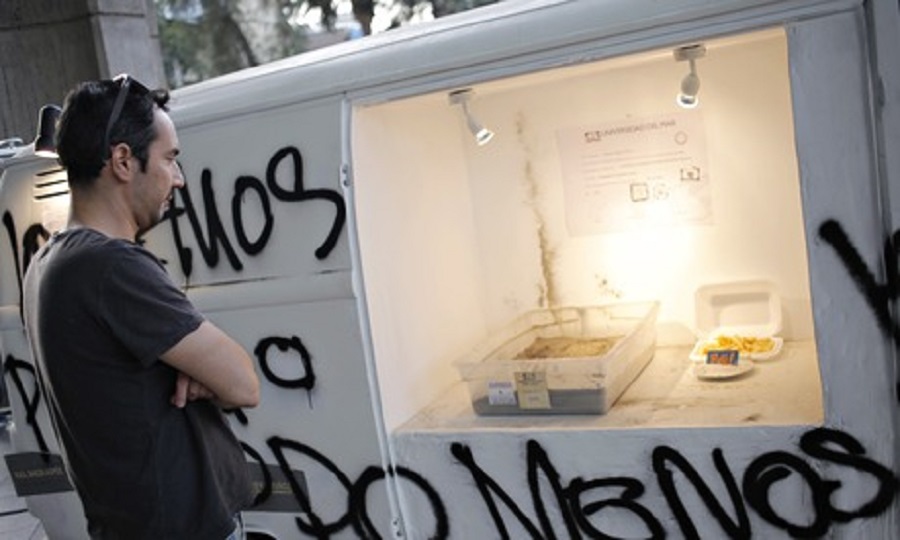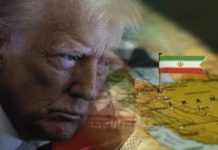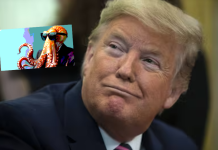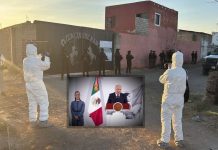In a world that needs less words and more acts, a committed group of artists is erasing that museum-conceived line that has separated Arts and Politics.
By Blaise Francis
Chilean artist Francisco Tapia A.K.A. Papas Fritas (‘french fries’, in spanish), single-handedly erased 500 million dollars worth of student debt at the University Del Mar last month. Somehow Tapia snuck his way into the records vault of this privately run, for-profit university in Chile and managed to burn countless debt papers that were needed to verify student debt. In Chile, in order to confirm the legitimacy of a student’s debt, one needs to have the original copy of the debt paper to verify its existence. So for now, it seems that Papas Fritas has truly and actually freed these students forever from their student debt.
I like to think of Francisco Tapia A.K.A Papas Fritas as a super hero, part of some justice league of artists fighting side by side with Bansky and Ai Wei Wei for the people’s rights. Banksy, if you don’t know, is the British street artist who has practically become a household name in most US cities for his anti-systemic street art. Ai Wei Wei is the controversial artist and activist from China who figured out how to use the cameras against the Communist Surveillance state. These types of artists are the most dangerous for establishments because of their ability to unify the public by succeeding where all the fed up activists have failed. Somehow Banksy, Ai Wei Wei, and now Papas Fritas have all figured out ways to have a somewhat mainstream influence on the public without being shut down or pushed out of the public eye.
In an effort to bolster and galvanize the people of Chile to fight for public education rights, Tapia later took the ashes of the burnt debt papers and put them in a white grafittied van where the ashes were displayed for all to see. He also made a Youtube video where he admits to his actions and talks about the current education problems in his country. Towards the end of the video, Tapia addresses the students of the university Del mar directly and announces that they are now free of debt and, “It’s all over now, you are free.”
Papas Fritas’ actions are in response to the ever growing education problem in Chile. People of lower socioeconomic backgrounds are being denied quality education and as a result have been boxed out of well paying jobs, thus repeating the cycle of poverty. The problem stems from a broken education system that grants private schools government subsidies for simply being in existence. These subsidies among many other flaws in the financial structure of the education system has led to an over abundance of private, for-profit schools and less access to quality education for all. In the last three years, Chile has seen a non-stop, barrage of student protest from occupations to marches sometimes reaching 1,000,000 in size.
The problem started in 1981 when former dictator Augusto Pinochet brought an end to free public education. Now protesters are demanding an end to what they call “Pinochet politics”. They believe that vast financial inequality in Chile is due, in a large part, to the education system. They see education as a way out of poverty and into better paying jobs, but because education is such a huge financial burden, no one from the lower class can afford it. And while protests that started in May of 2011 have only wavered slightly in the last year, Papas Fritas has breathed new life into the cause by creating such a meaningful and daring piece of art.
The question remains whether Papas Fritas really committed a crime in burning these papers that were not his property. But somehow, private property is not an issue for this kind of art. Even more, Chilean legislation clearly states that no university can profit – all their earnings (from student’s families and state subsidies) must be re-invested in their operations and infrastructure. That was not the case with the University Del Mar, as an investigation concluded that they were making huge amounts of money by triangulating funds from one entity to another to skip justice.
There’s something special about activists that are also artists or artists that are also activists. When an artist actively rebels against an establishment and truly succeeds in making a difference and does so by creating a meaningful and relevant piece of art, the seeds of action are planted. Maybe its because some artists, and some art for that matter, seem to be able to articulate so well the pain and frustration of a people. Whether its a powerful piece of art making a bold statement that resonates with people or in Papas Fritas’ case, a powerful statement that has made his art so powerful, it doesn’t really matter. What is important to realize, is that activism and art have a natural relationship. Art and activism in a lot of ways attempt to do the same thing, humanize those who have lost their humanity and empower those who haven’t.








